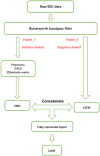A multi-frame network model for predicting seizure based on sEEG and iEEG data
- PMID: 36452007
- PMCID: PMC9701721
- DOI: 10.3389/fncom.2022.1059565
A multi-frame network model for predicting seizure based on sEEG and iEEG data
Abstract
Introduction: Analysis and prediction of seizures by processing the EEG signals could assist doctors in accurate diagnosis and improve the quality of the patient's life with epilepsy. Nowadays, seizure prediction models based on deep learning have become one of the most popular topics in seizure studies, and many models have been presented. However, the prediction results are strongly related to the various complicated pre-processing strategies of models, and cannot be directly applied to raw data in real-time applications. Moreover, due to the inherent deficiencies in single-frame models and the non-stationary nature of EEG signals, the generalization ability of the existing model frameworks is generally poor.
Methods: Therefore, we proposed an end-to-end seizure prediction model in this paper, where we designed a multi-frame network for automatic feature extraction and classification. Instance and sequence-based frames are proposed in our approach, which can help us simultaneously extract features of different modes for further classification. Moreover, complicated pre-processing steps are not included in our model, and the novel frames can be directly applied to the raw data. It should be noted that the approaches proposed in the paper can be easily used as the general model which has been validated and compared with existing model frames.
Results: The experimental results showed that the multi-frame network proposed in this paper was superior to the existing model frame in accuracy, sensitivity, specificity, F1-score, and AUC in the classification performance of EEG signals.
Discussion: Our results provided a new research idea for this field. Researchers can further integrate the idea of the multi-frame network into the state-of-the-art single-frame seizure prediction models and then achieve better results.
Keywords: EEG; deep learning; feature extraction; multi-frame network; pre-ictal; seizure prediction.
Copyright © 2022 Lu, Zhang, Wu, Ma, Zhang and Ni.
Conflict of interest statement
The authors declare that the research was conducted in the absence of any commercial or financial relationships that could be construed as a potential conflict of interest.
Figures












Similar articles
-
Multifuse multilayer multikernel RVFLN+ of process modes decomposition and approximate entropy data from iEEG/sEEG signals for epileptic seizure recognition.Comput Biol Med. 2021 May;132:104299. doi: 10.1016/j.compbiomed.2021.104299. Epub 2021 Mar 3. Comput Biol Med. 2021. PMID: 33711557
-
Deep-learning-based seizure detection and prediction from electroencephalography signals.Int J Numer Method Biomed Eng. 2022 Jun;38(6):e3573. doi: 10.1002/cnm.3573. Epub 2022 May 13. Int J Numer Method Biomed Eng. 2022. PMID: 35077027
-
Pediatric Seizure Prediction in Scalp EEG Using a Multi-Scale Neural Network With Dilated Convolutions.IEEE J Transl Eng Health Med. 2022 Jan 18;10:4900209. doi: 10.1109/JTEHM.2022.3144037. eCollection 2022. IEEE J Transl Eng Health Med. 2022. PMID: 35356539 Free PMC article.
-
EEG-Based Seizure detection using linear graph convolution network with focal loss.Comput Methods Programs Biomed. 2021 Sep;208:106277. doi: 10.1016/j.cmpb.2021.106277. Epub 2021 Jul 13. Comput Methods Programs Biomed. 2021. PMID: 34315015
-
The performance evaluation of the state-of-the-art EEG-based seizure prediction models.Front Neurol. 2022 Nov 24;13:1016224. doi: 10.3389/fneur.2022.1016224. eCollection 2022. Front Neurol. 2022. PMID: 36504642 Free PMC article. Review.
Cited by
-
Automatic detection and prediction of epileptic EEG signals based on nonlinear dynamics and deep learning: a review.Front Neurosci. 2025 Aug 18;19:1630664. doi: 10.3389/fnins.2025.1630664. eCollection 2025. Front Neurosci. 2025. PMID: 40900924 Free PMC article. Review.
-
Research progress of epileptic seizure prediction methods based on EEG.Cogn Neurodyn. 2024 Oct;18(5):2731-2750. doi: 10.1007/s11571-024-10109-w. Epub 2024 May 7. Cogn Neurodyn. 2024. PMID: 39555266 Review.
References
-
- Abdelhameed A. M., Bayoumi M. (2018). “Semi-supervised deep learning system for epileptic seizures onset prediction,” in 2018 17th IEEE International Conference on Machine Learning and Applications (ICMLA) (Orlando, FL: IEEE; ), 1186–1191.
-
- Abdi H., Williams L. J. (2010). Principal component analysis. Wiley Interdisc. Rev. Comput. Stat. 2, 433–459. 10.1002/wics.101 - DOI
-
- Anandaraj A., Alphonse P. (2022). Tree based ensemble for enhanced prediction (teep) of epileptic seizures. Intell. Data Anal. 26, 133–151. 10.3233/IDA-205534 - DOI
LinkOut - more resources
Full Text Sources

